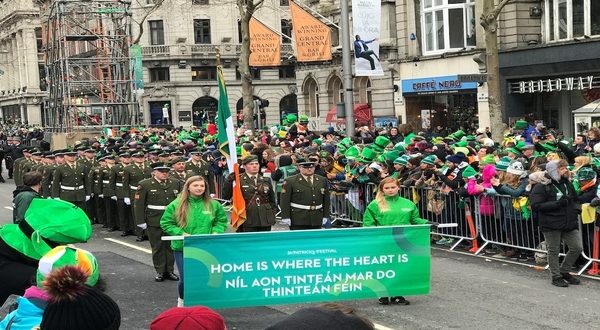[ad_1]
When it would come up in conversation that I was to be in Dublin for St. Patrick’s Day, responses tended to fall into similar categories, depending on which side of the water the listener was from.
Most Americans were jealous, confessing a visit to the Emerald Isle for the country’s national day to be among their “bucket list” items. The Irish, on the other hand, reacted either with characteristic dismissiveness: “Oh, do you really want to come and deal with all that, then? I haven’t been to the parade for years” or downright fatalist concern for my wellbeing: “Bundle up: the weather’s always terrible on St. Paddy’s!”
That sort of disparate response from two different cultures is, for a writer, simply too delicious to ignore. Off it was, then, to Dublin (Baile átha Cliath in Irish) to get to the bottom of two different perspectives on what is the world’s most widely celebrated national day outside its country of origin.
St. Patrick’s Day is more than just Ireland’s national day. It’s the feast day for Saint Patrick, originated in the Catholic Church and venerated by several other denominations. In modern times, it’s become a worldwide celebration of Irish identity and culture.
That it’s a global event is no wonder, owing to the size of the Irish diaspora: estimated to be in the neighborhood of 75 million worldwide. That’s just over ten people with Irish heritage living outside Ireland for every inhabitant of the island itself.
Dublin’s city center was certainly lively, but not jam-packed in the days leading up to the festival’s parade on the 17th of March. Popular tourist attractions like the Guinness Storehouse and Teeling’s Distillery (both absolutely worth a visit, by the way) didn’t seem particularly more crowded than normal, although the patronage skewed heavily American, many of whom seemed perfectly satisfied hunting for the meaning of Irish heritage in the bottom of a glass.
Pubs in the city center overflowed on the actual day, however, both before and after the parade with scenes not entirely different from what one might find stateside: plenty of themed swag from purveyors of adult beverages worn by merry revelers—again mostly Americans whose major takeaway from the day was that “traditional” green beer is primarily an American affectation.
Several of the Irish I spoke with (more than one of whom warned about the general intoxication of the parade-goers) would perhaps have been surprised at how tame the parade crowds were. If there was any imbibing in the street, it was well-hidden, and in spite of the as-promised foul weather (cold and blustery with intermittent snow flurries,) the high spirits of the crowd struck as almost entirely organic.
The parade itself was a heady brew of expected tropes and new surprises. The pageantry of tartan-wearing first responders and service organizations with drums and bagpipes is to be expected—it’s a powerful mark of cultural and community pride in addition to being exactly what the foreign visitors expect to see on their visit.
Slightly more unexpected were the number of American high school and college marching bands participating in the parade, which oddly seemed not entirely out of place interspersed with the Irish street art troupes dressed as seagulls, giant bugs or the Celtic war goddess Banba, each in celebration of the parade theme of “Home” for the Irish, whether in Ireland or part of the Irish diaspora abroad.
But what of the Irish on St. Patrick’s Day? Back on the streets of Dublin after the parade, it was more of the pub and party crowd. The answer came when I got back to my hotel, Buswell’s where the bar and lounge were packed with local families comfortably ensconced by the fire, enjoying tea and perhaps a slowly consumed pint, and I began to realize how much the theme of the parade actually struck at the heart of the Irish celebration of St. Patrick’s Day—a day here as often celebrated by hearth and home with family than in a crowded mess of intoxicated strangers.
With that in mind, I began to think back to the parade, where I noted “hearth” and “heart” were also themes presented by some of the myriad street performers, and realized that the celebration of Irish identity wasn’t limited to the island of Ireland itself.
Almost central to the identity of Irish is the global nature of the Irish people that resulted in their national day being celebrated far and wide. For the Irish, home and hearth are where ever they land; whether it’s in Dublin or anywhere else in the world, being Irish means feeling at home.
Travel and accommodations were furnished by Failte Ireland in preparation for this story.
[ad_2]You can read more of the news on source
 Travelsmart
Travelsmart



